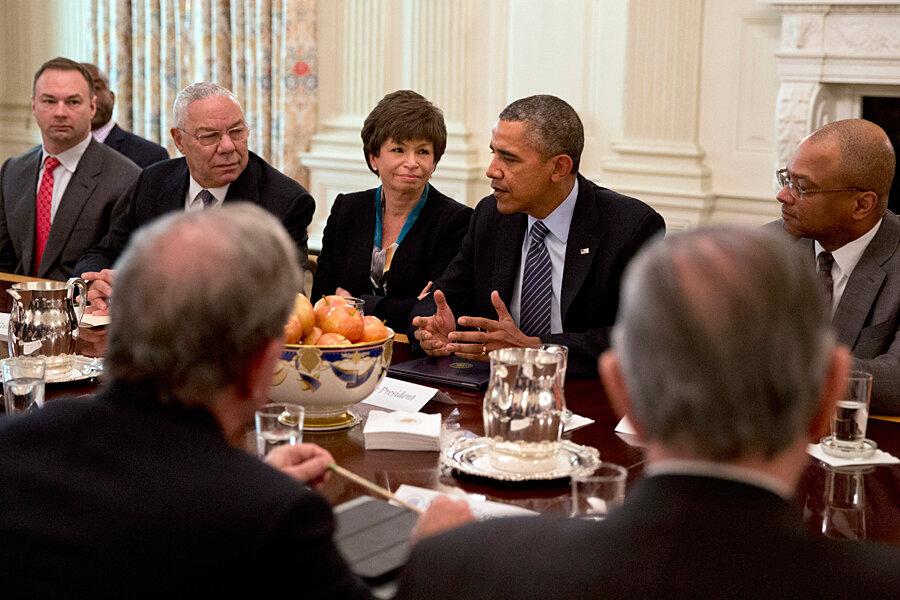'Discipline reform' is in Obama program to help young men. What's that mean?
Loading...
When President Obama announced “My Brother’s Keeper” Thursday, he identified school discipline reform as one key to supporting the success of young men of color.
School suspensions and expulsions, which occur more often among black and Latino boys, make dropping out of school – and the host of risk factors that come with that – more likely.
“My administration has been working with schools on alternatives to the so-called zero-tolerance guidelines – not because teachers or administrators or fellow students should have to put up with bad behavior, but because there are ways to modify bad behavior that lead to good behavior,” Mr. Obama said in announcing My Brother's Keeper.
By building on the work already started – with some of the $200 million pledged by philanthropies for My Brother’s Keeper – “we can keep more of our young men where they belong – in the classroom, learning, growing, gaining the skills they need to succeed,” the president said.
The Atlantic Philanthropies, for one, has spent $40 million already on reducing discipline disparities and has pledged another $70 million for that work as part of My Brother’s Keeper. It gave $1 million to the Annenberg Institute for School Reform at Brown University in Rhode Island to set up a network of four cities – New York; Los Angeles; Chicago; and Nashville, Tenn. – to share reform strategies and examine their policies.
For years, civil rights groups have been campaigning for schools to move away from zero-tolerance policies that have led to what they term the school-to-prison pipeline.
Some conservative critics and educators worry that a shift away from such policies, or too much emphasis on tracking the race of students suspended, might prompt teachers to allow more disorder. But increasingly, urban school leaders and state legislatures are turning to a range of strategies to make school discipline more positive and equitable.
Here are some examples:
• Making fewer offenses punishable by suspension or expulsion. Up to 95 percent of out-of-school suspensions are for nonviolent behavior, US Secretary of Education Arne Duncan said in a recent speech highlighting new discipline guidance disseminated to schools. “Being disruptive, acting disrespectfully, tardiness ... are all issues that must be dealt with,” he said. But “is putting children out of school the best remedy?”
Nearly a decade ago, Baltimore public schools changed the code of conduct, added more mental health professionals, and offered more mediation for behavior problems. They lowered suspensions from 26,000 in 2004 to 8,600 last year.
The Los Angeles Unified School District passed a School Climate Bill of Rights in 2013, no longer allowing suspension for the broad category of “willful defiance,” which activists say contributes to racial disparities. Other cities, ranging from Philadelphia to Denver, have similarly changed policies to reduce suspensions for minor infractions.
• Creating a positive school climate. Schools are increasingly fostering a culture of positive behavior and addressing underlying causes of misbehavior – everything from mental health issues to substance abuse. The US Department of Education recently announced School Climate Transformation Grants that will help more than 1,000 schools offer training in research-based strategies.
One common framework is Positive Behavioral Interventions and Supports (PBIS). The school works with parents and students to set up common expectations and then offers more interventions for students having trouble meeting them. Once teachers are trained, they tend to be able to handle more problems within the classroom and to be more consistent and fair in referring students to the principal's office for discipline.
• Shifting the role of police in schools. Colorado passed a law in 2012 that required schools to minimize referrals to law enforcement and implement more prevention strategies. It also required more training of school-based police officers.
The new policy in Los Angeles also includes a review of school police practices, and it directs schools to move away from arrest-driven enforcement models of discipline.
• Using restorative justice. This approach – which helps prevent conflict and requires students to make reparations if they’ve harmed people – has been a key strategy in a number of cities. As part of an effort in Oakland, Calif., it is integrated into more than a dozen schools so far to make discipline more positive and fair. At one alternative high school there, suspension rates were cut in half within the first year of shifting to restorative justice.
• Practicing culturally responsive education. Some school districts are training teachers to be more aware of possible hidden biases that may lead them to discipline students of color more severely. A recent Colorado Public Radio story quoted Darlene Sampson, Denver schools’ director of culturally responsive education, describing a series of questions she has teachers ask themselves to see if they are treating minority students differently: “Do I call on you? Do I have physical proximity to you? How do I feel about you in terms of your skills and abilities?... Do I advocate for you early on to think about you going to college? Do I have a great relationship with your parents?”
If teachers aren’t engaged with students, “they also disengage, and it becomes a very insidious cycle,” Dr. Sampson said.






